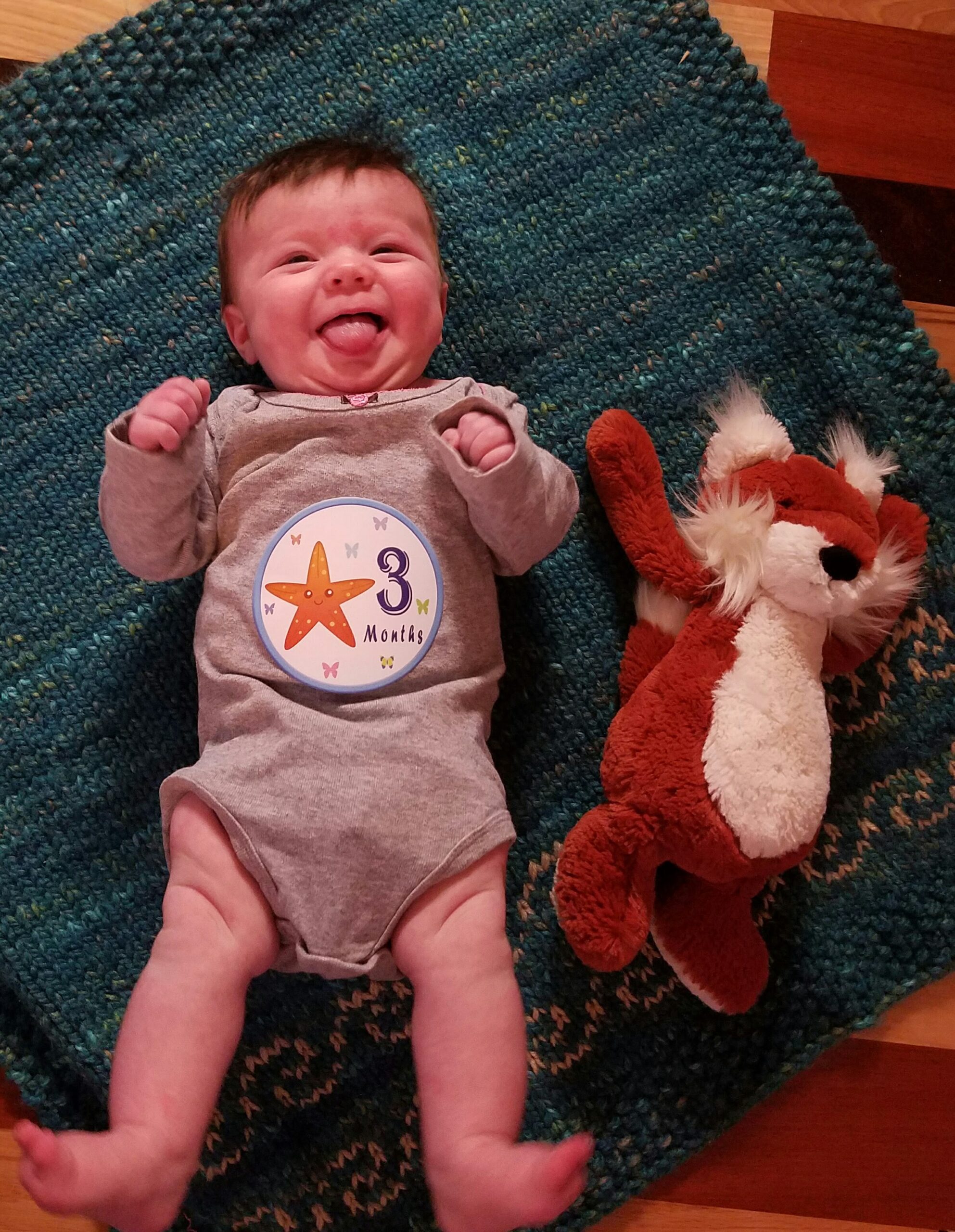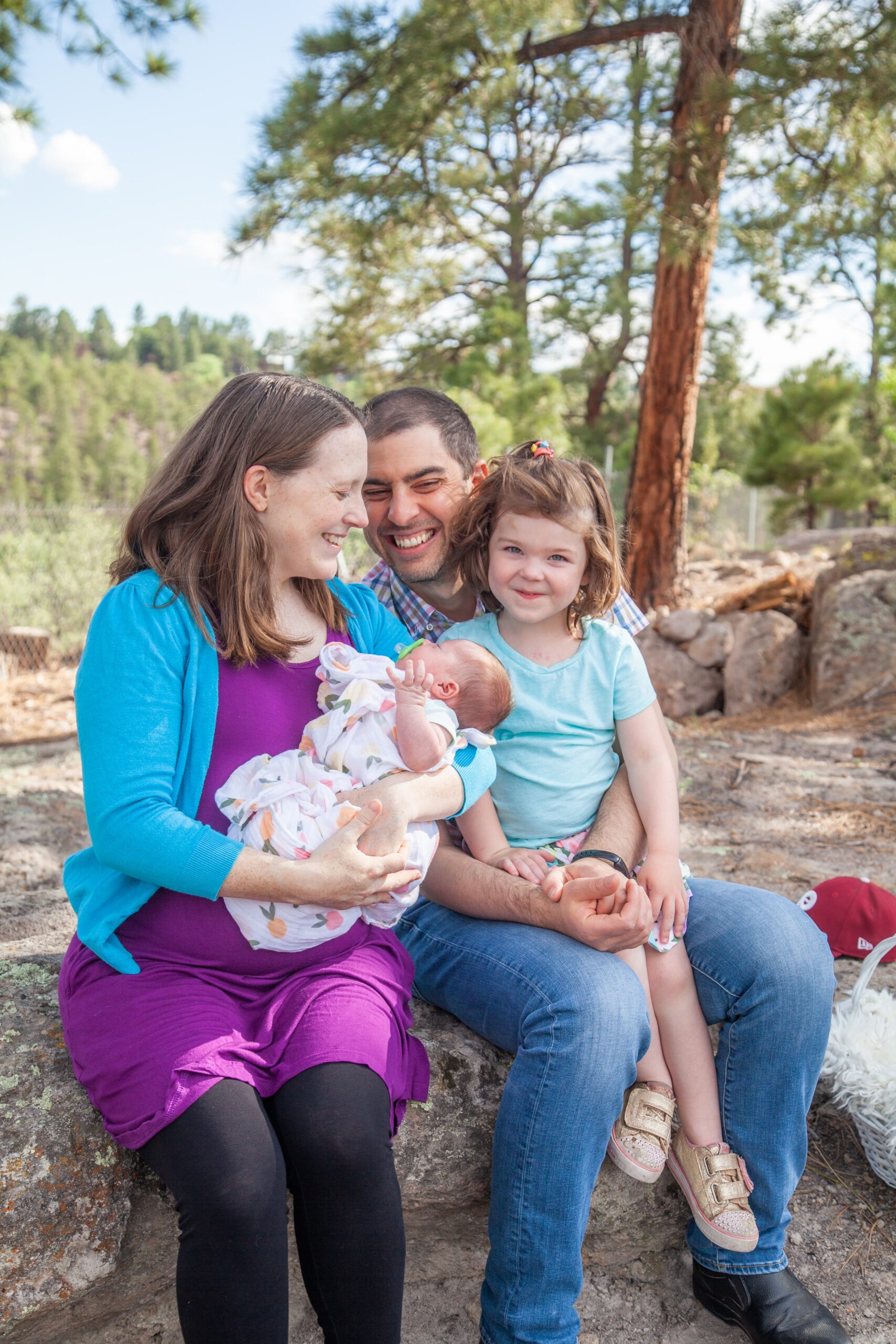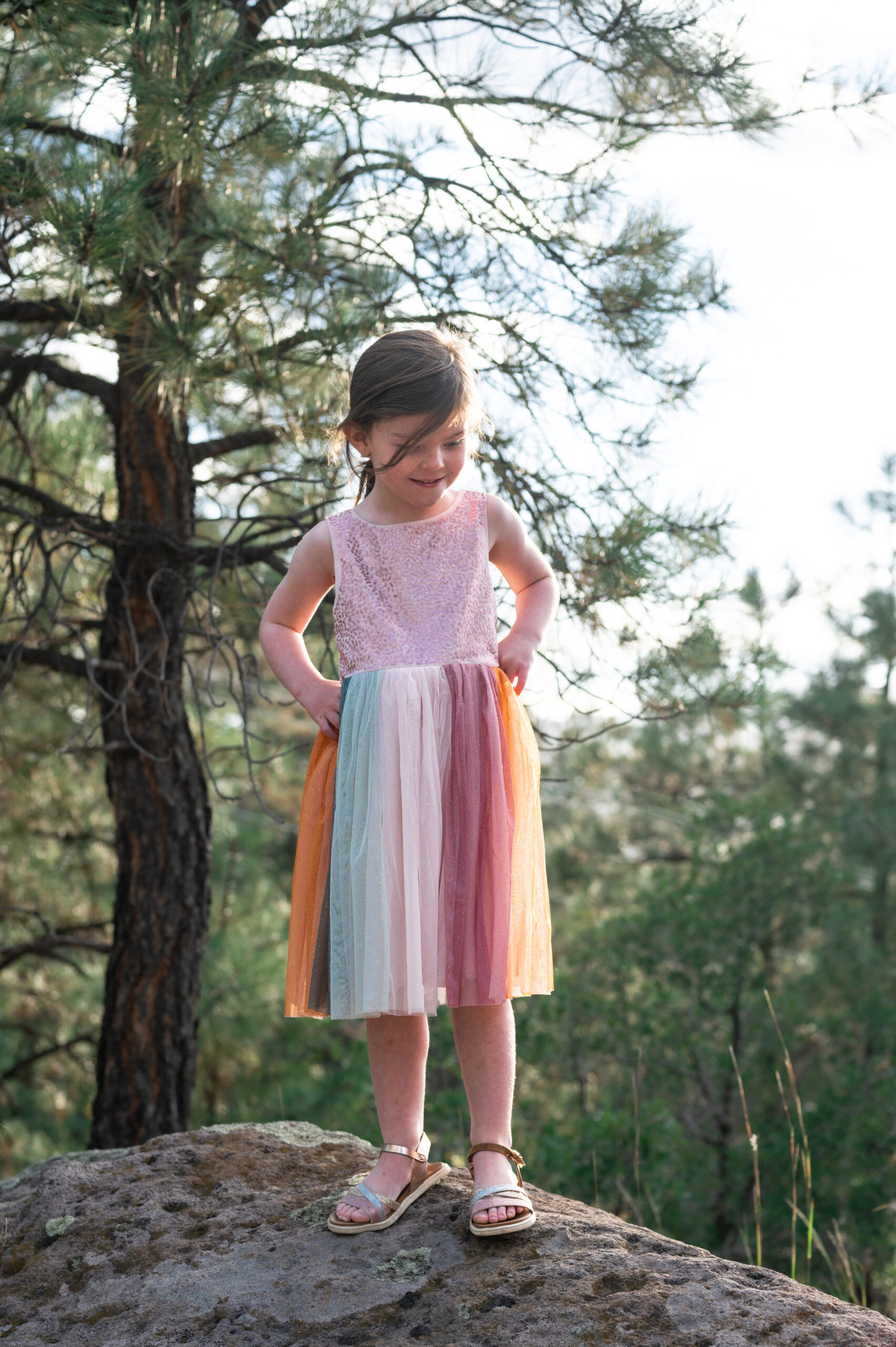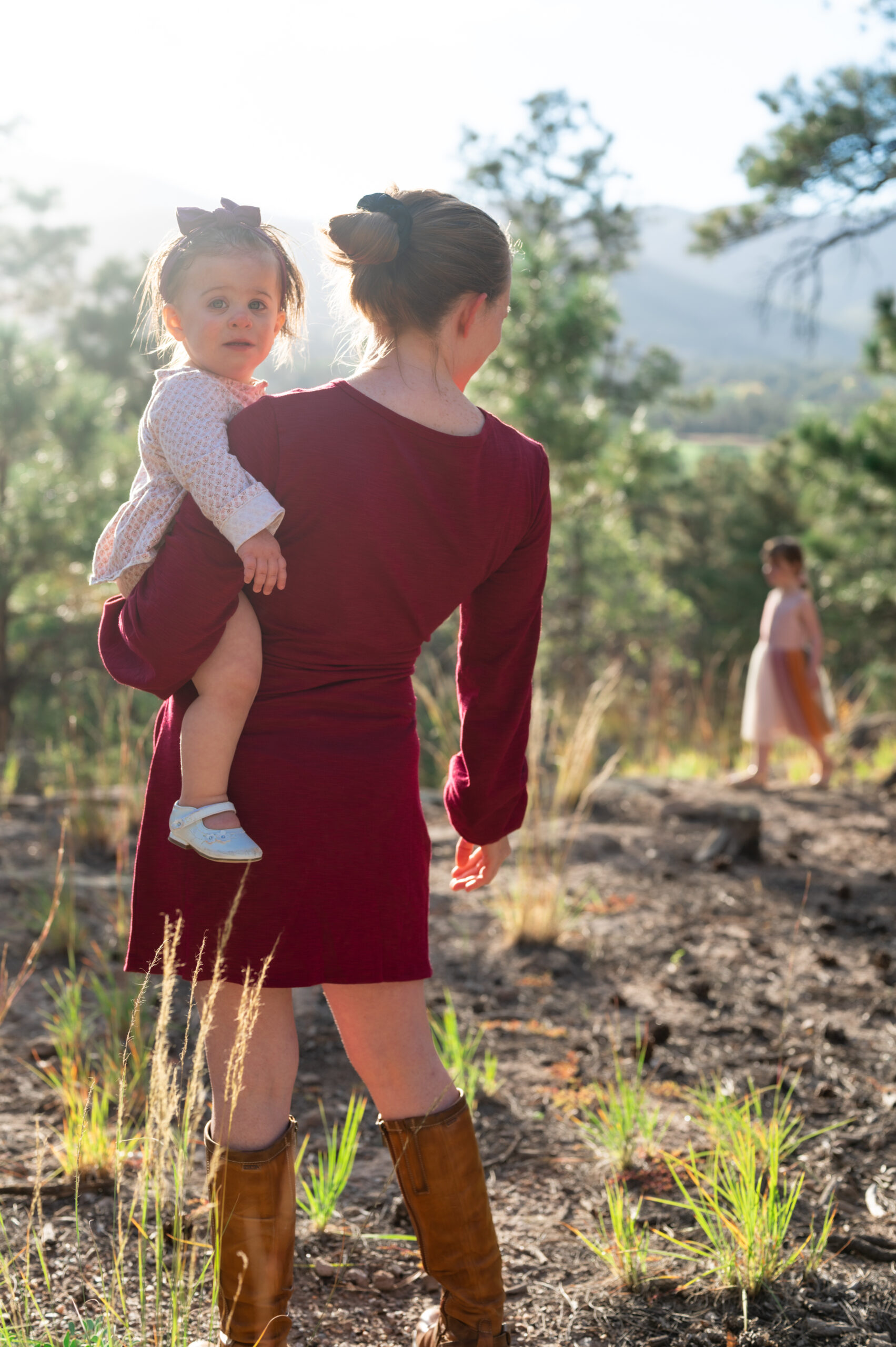Courtesy photo: Sofie and Mom on an outdoor adventure.
Adventures in Parenting: Girls with Autism
By Amanda Zengel
When I had my first daughter, Sofie, in 2016, it was a dream birth. My waters broke at 34 weeks and she was ready. After an easy delivery, I looked in her eyes and thanked her for such a beautiful experience. When I returned to work as a middle school teacher, my husband’s parents cared for her and she was such a happy baby. She ate, played, and slept on a schedule, she enjoyed meeting new people, and she loved cuddles. Sofie met all her milestones and her pediatrician never had any concerns. When I mentioned her fascination with light coming through the blinds, her inability to hang on when being carried, and her lack of fear, I was assured that those were new-mom worries.
Like many families, we moved to Los Alamos when my husband was hired at the lab. Also, like many families, we had to find alternative housing for the first few weeks and ended up at Buffalo Thunder Casino. I had an adorable cockapoo dog and an adorable 22 month old toddler who charmed everyone. Sofie made eye contact, said hi to strangers, and pretty much ran the resort by the time we checked out. Everyone commented on how independent and confident she was. She was confident, that’s for sure. When we got in the pool, she refused to hang on and sank straight down. Rather than change strategies, she preferred to physically fight any effort by me to prevent drowning. We stuck to the splash pad. Sofie also had a hard time staying together with mom, dad, or any caretaker. Once she stayed in the elevator when everyone else got off, the door closed, and off she went. When I finally caught back up with her, she was calm and unconcerned about her solo trip. My new-mom worries were piling up.
As we settled into life on the mesa, I realized I was parenting on super hard mode. Sofie was easy to potty train but held it for 12 hours. She started refusing foods she had eaten many times before, and was reluctant to try new foods. Her preferred activities were digging in the mud and dumping lotion. She had to do everything herself but could not copy if someone showed her how. She made up her own way to get stuff done, with many, many hours of frustration. Her tantrums could last up to an hour.
The pandemic forced us outside for hours of hiking and exploring playgrounds, and I realized she did not understand pointing (joint attention). She couldn’t follow my finger if I was showing her something, and she did not use pointing to show me things. She also did not want to be carried. She took so many risks I had to be within arms length to prevent injuries. Sofie would follow other kids around, but not engage or respond if they tried to engage with her. Other parents said I didn’t need to hover and she would work things out on her own, like their toddlers, but I knew from the look of terror on her face, she needed extra support.

Courtesy photo: A happy baby: Sofie at three months old.
At her in-home play-school, she got along with the other children and seemed to enjoy herself. Eventually she started having extreme separation anxiety at drop-off. I was assured this was normal. Sofie started to become hyper focused on anything she did not feel was fair and any perceived slight. When she was so overwhelmed she started name calling and attacking the other kids, I pulled her out in favor of a more structured Montessori preschool. With only four children (thanks, COVID!) and a very experienced teacher, I was hoping she would thrive. This teacher was the first adult to comment on her challenging behavior. She told me Sofie was one of the smartest students she had worked with, but she did not have the coping skills to handle the demands of a classroom. The Montessori school closed permanently because of COVID, so with the recommendation of her teacher, I asked the Los Alamos Public Schools to evaluate Sofie for developmental delays to see if she qualified for Pre-K3.
Sofie has always been extremely verbal. She could listen to read-aloud books for hours. She could identify the emotions of characters, discuss plot lines, and guess what might happen next. Her memory was insane. The challenge came when talking with other children. She was terrified. She usually avoided talking completely unless it was someone she was comfortable with, and then she couldn’t stop talking. The public school evaluation confirmed my suspicion that Sofie’s verbosity could not be understood by people outside of our family and friends. She qualified for PreK3 for unintelligible speech. Even this qualification was a stretch: she did amazing on every part of the evaluation, and the speech language pathologist had to take my word for her skills in a typical situation. Sofie can pass any test given her optimal environment.
In addition to children, Sofie became scared of many other things including footsteps coming closer (even if she knew who it was), bathing, bugs, hanging upside down, unexpected sounds, crowds of people, bathrooms, and being alone. Her reaction to these fears was to either zone out or run. Most of the time she appeared calm on the outside, but I knew something was wrong. Sofie also did not register pain like most kids. Adults could not believe her ability to fall and get right back up. She was so tough. Unfortunately, that also meant not knowing if she was sick or injured until it became severe. As her main caretaker I suspected she had injuries and illnesses she was not complaining about, but taking her to the doctor because I had a feeling did not seem rational. Sofie even repressed any sign of pain when we took her in for an elbow injury. I took her back for an X-ray after she brought me a blanket and asked me to wrap up her arm. The elbow was broken. My new-mom worries were turning into feelings of overwhelm and desperation.
At this point I was pregnant and tired. Sofie needed my constant supervision. I tried everything. Reward charts, visual schedules, strict routines, relaxed schedules, increasing outdoor time, bribing, simplifying my language, zero screen time, vitamins, more socialization, less socialization, sleep clocks, changing her diet, validating feelings, kids yoga, and reading books about emotions and coping and being nice. Nothing had much of an impact on Sofie, and some strategies backfired completely.

Courtesy photo: Baby sister arrived June 2021.
The stress of the pandemic, a high-risk pregnancy, and no opportunity to relax meant my relationship with my husband became frayed. It took me a year to completely recover after a traumatic birth with my second daughter. During this time my husband was working full time, taking care of regular household duties and attempting to supervise Sofie. Our house was dirty and disorganized. Our new baby wouldn’t sleep unless I held her. Sofie was causing chaos in PreK 4. Maintaining any semblance of a romantic relationship was impossible. And if we were struggling to put in a grocery pick-up order before we ran out of coffee, how could we possibly be thoughtful partners? This is an ongoing struggle.
I will be forever grateful for the school employees who spent hours with Sofie while she melted down, screamed, ran away, and tried to attack anyone who came near her. Their notes and academic records helped give me the courage to contact Layne Kalbfleisch at 2E Consults in Española. Dr. K works with neurodivergent people of all ages who are highly intelligent, creative, or exceptional in other ways and who also struggle with antisocial behaviors, communication, and learning difficulties.
After a three-day in-person evaluation with Sofie, two parent interviews, and surveys completed by Sofie’s teachers, we received a 75-page report. Sofie is autistic and highly intelligent with ADHD and possibly dyslexia. My parenting world changed that day. I felt validated for the first time in six years. I felt guilty about not getting an evaluation earlier and ashamed about the demands I placed on my daughter that were clearly not appropriate. Thanks to a good therapist (shout out to Francesca!) I processed my initial feelings of failure quickly, and started researching Sofie’s place on the autism spectrum.
According to a meta analysis published in The Journal of the American Academy of Child and Adolescent Psychiatry, boys outnumber girls with an autism diagnosis by three to one. Many pediatricians, who are often the gatekeepers for referrals for further evaluations, do not recognize the behaviors that may indicate autism in girls. I never saw the stereotypical signs of autism in Sofie, such as lining items up, robotic speech, hand-flapping, avoiding eye contact, limited fine motor skills, or not enjoying pretend play. She wasn’t into wheels or things that moved. She was passionate about cutting up paper into tiny pieces, and making massive multimedium art projects.

Courtesy photo: Sofie loves to climb—no fear.
Sofie is considered autistic with Pathological Demand Disorder (PDA). PDA is a nervous system disorder that is caused by an overactive amygdala. The result is a child whose brain is sending constant danger signals and activating the nervous system in preparation for the fight for survival. Neurotypical brains can usually distinguish danger from safety, and children are typically very sensitive to the reactions of the more experienced people around them. Autistic people with a PDA profile do not take in information the same way. Their amygdala sends the danger signal for everything. Eventually, similar to people with PTSD, they can be triggered by any loss of control. My daughter was triggered by hearing “no” in any context, not being able to choose activities, not being line leader, and anything she determined to be unfair. Sofie would run (flight) and attack or destroy (fight), but her main stress responses in public were freezing (zoning out) or fawning (focusing on people pleasing). In girls, this appears as absent-minded, spacey, people-pleasing, and clingy. It also means they are repressing emotions and using every ounce of self control in school and extracurriculars. The meltdowns at home, seemingly about nothing, increase in severity and length. They lose any trust they had in their caregivers and often shut down completely. As social and academic demands increase, some kids lose their ability to speak, regress with toilet training, and become socially isolated.
As soon as I understood how my daily demands were overwhelming Sofie, I stopped making so many demands on her. We are slowly building trust and having fun again. She is still struggling with emotional regulation but over reactions don’t phase me as often. I don’t know if my youngest will be diagnosed with autism, but experience has shown me how important it is to have all the information in order to support kids as individuals.
I am not perfect. I’ve second guessed myself, and failed in so many different ways. But in the end, I know I’m the perfect mom for my girls. I will always be thankful to them for this beautiful—if challenging—adventure.
Amanda Zengel is a former middle school teacher, a stay at home super parent, and a local childcare coordinator for Cultural Care Au Pair, and works at the STEAM Lab in Los Alamos.



